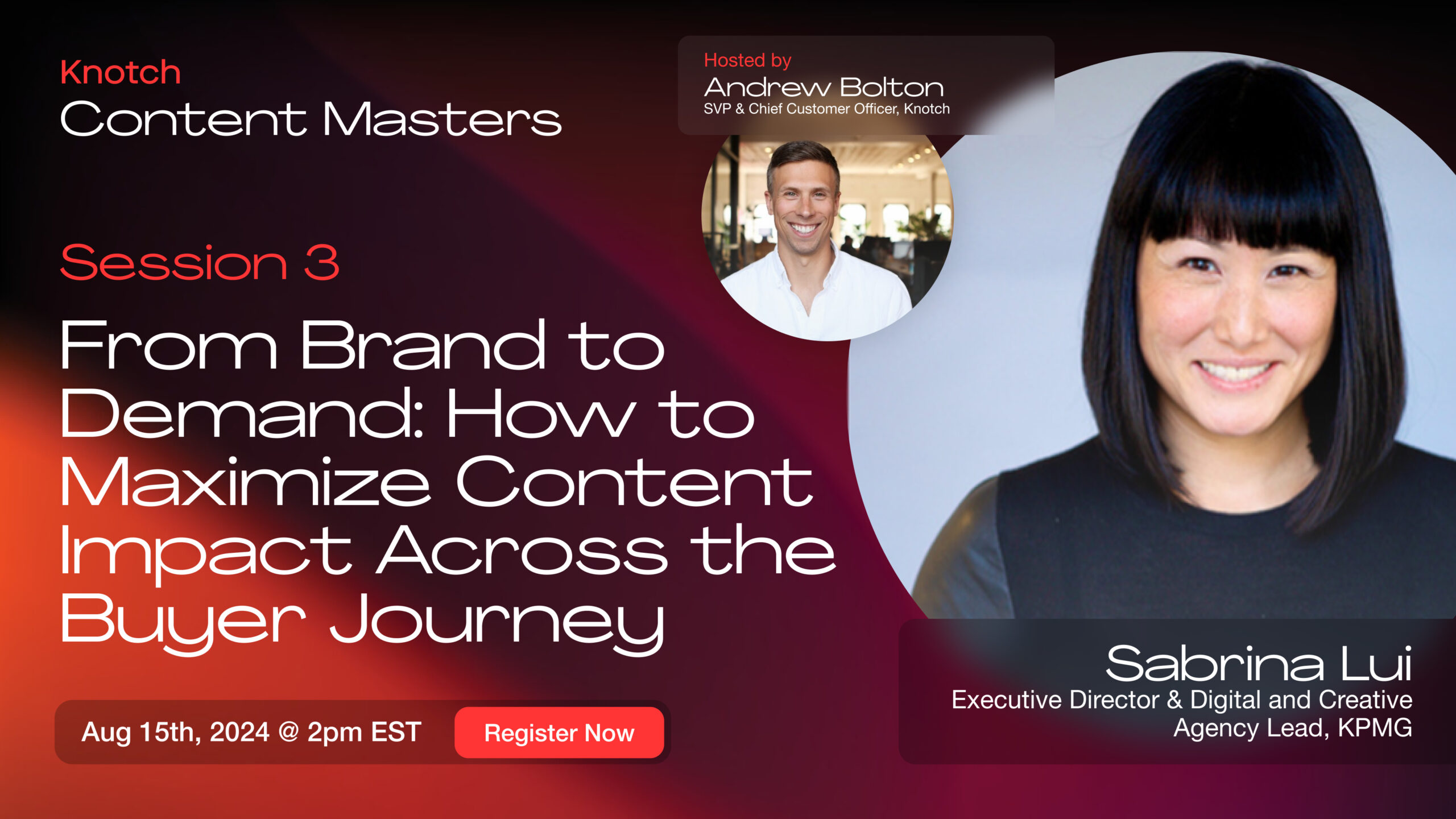What have been the top trends and priorities for digital marketers in 2022? And what do they consider the most burning challenges and opportunities for growth in the months ahead?
We did the legwork so you don’t have to — we’ve analyzed our many firsthand conversations with growth, demand, and content leaders and combined it with papers, research, and what other marketing experts are saying in the field.
Here are the key trends and takeaways across the board.
What did growth, demand, and content leaders prioritize in 2022?
Marketing leaders had a lot on their plate this year. Across industries and company sizes, these were some of their top priorities.
How to continue growing in an uncertain market
The recession hasn’t landed yet, but its looming presence means more scrutiny on budgets. For marketing leaders, that requires tying activities to business outcomes and proving return on investment.
Even harder, marketing jobs are on the line. There’s no shortage of #openforwork posts on LinkedIn and monthly layoffs, especially within tech.
Even with rising pressure, there are ways to avoid losing budget AND make each dollar more effective. Janet Balis, EY Global Advisory Services Leader, shared several tips for maneuvering marketing teams around economic uncertainty:
- Keep open communication with your CEO and CFO, helping them understand the value of harder-to-track marketing activities while also recognizing that “[?l]eaders under economic pressure will likely prioritize short-term measures of growth…such as search, social, and e-commerce.”
- Embrace speed and agility within your marketing function.
- Take advantage of less competition. As other marketing teams dial back marketing spending, smart marketers will see this as an opportunity to find the gaps to their benefit.
- Marketing leaders need to be data-centric and “champions of disciplined use of data and technology to connect the end-to-end customer journey across business functions.”
Whether or not your budget shrinks, it’s imperative to find ways to make your current marketing budget more efficient.
One option: Make your existing investments work harder. It’s what Andy Ramirez, VP of Growth Marketing at New Relic, called “Moneyball content creation,” where you get more from less by repurposing existing marketing materials.
Ultimately, having audience journey data to back up your marketing spend will prove to you and leadership where it’s most efficient and effective.
Prioritizing the good
Environmental, social, and governance (ESG) was a priority across the organization for many companies. Beyond sustainability, hiring diversity, and other key initiatives, much of the brand positioning and external communication fell on marketing leaders.
After all, 70% of consumers want brands they support to address social and environmental issues. But brands are treading lightly.
And according to Deloitte, inauthentic brands receive harsh criticism and blowback, often being labeled as “woke-washing.”
So how can marketing teams get it right?
- Sara Bernow, who leads McKinsey’s work in sustainable investing, says that smart ESG efforts should “address the ESG factors that are material to their industries,” like sustainable packaging in a consumer brand or hiring underrepresented talent in tech.
- They’re keeping their missions aligned with what they support. DoorDash, for example, publishes an annual ESG report that outlines their approach to growing local economies as an integral part of their business model.
- Teams should create strict criteria for what social and environmental issues to engage with where they can make meaningful, impactful change.
- They’re making sure all internal stakeholders agree with the company’s public stance by having honest and clear conversations, weighing varying opinions with discernment.
Adopting a multi-channel mindset to drive conversions
Customer journeys aren’t linear. These days, you can’t run an ad and expect an immediate conversion every time. Today’s B2B consumers “often use more than nine channels on their buying journeys,” according to research from McKinsey.
Jacalyn Beales, Manager, Demand Generation at Lever, shared with us that her biggest focus for 2022 was breaking away from a top-middle-bottom funnel mindset to see the entire journey.
“There’s a serious need for driving value at every stage [that] humans interact with your business,” she said. “This means tying your content strategy to your demand strategy and includ[e] growth, from a testing perspective. We want to understand the potential of meeting people wherever they happen to be — with the right help, the right education, and the most value.”
Many marketers are moving away from the traditional mindset of customers flowing neatly from top to middle to bottom of the funnel.
“People don’t work that way,” said Phoebe Noce, Knotch’s Director of Content Marketing, in a recent podcast episode. “They can go from an awareness piece of content to a landing page, to another awareness piece, to a conversion. Customers don’t follow prescribed paths.”
Love it, or hate it, these convoluted journeys are the norm. To help, we’ve outlined several ways to improve your marketing campaigns with audience journey data.
What are the biggest challenges marketers faced in 2022?
There were many hurdles for marketers in 2022. These are some of the key challenges we heard consistently.
Marketing attribution
Marketing activities are increasingly being tied directly to pipeline or revenue, making attribution models a key topic of discussion.
But 41% of marketing teams, according to Digiday, still base most of their marketing decisions on “last-touch” attribution models, which inaccurately weights the end of the journey and ignores how demand was created, reengagement, and the middle touchpoints that propelled the customer.
Other marketers adopted different attribution models to try to solve for this (linear, time decay, u-shaped, w-shaped, z-shaped).
Add on to this the difficulty of tracking attribution off-domain across dark social — social media, private messaging, online communities, word-of-mouth, etc.
Many companies are solving for this problem with self-reported attribution via a “Where did you hear about us” open text box in a form.
And for on-domain attribution, they’re leveraging customer journey tracking and intelligence to understand what pages, content, and referral sources are both directly and indirectly impacting pipeline.
Customer retention
New customer acquisition was a challenge for marketers in 2022, but so was keeping them.
Economic uncertainty is putting pressure on marketers to increase retention rates. Why? Acquiring a new customer can be five to 25 times more expensive than retaining an existing one.
With a recession on the horizon, both consumers and businesses are cutting back, resulting in lower expected sales across the board. As a result, many companies are turning their focus toward retention, cross-sell, and upsell to drive revenue growth.
In fact, experts like Mary Pilecki, VP and Principal Analyst at Forrester, advise marketers to shift their attention to tactics such as loyalty programs to drive purchases, improve onboarding, and even acquire new customers.
“Does it work?” she asks. “According to [Forrester’s] Global Marketing Survey 2022, the answer is yes: Loyalty programs are among the top five most effective owned marketing tactics across all stages in the customer lifecycle.”
Sales and marketing alignment
Sales and marketing alignment isn’t a new issue. LinkedIn found that 90% of sales and marketing professionals butt heads on strategy, processes, content, and culture.
Alignment will still be an issue in 2023 but much of the struggle is tied back to who gets the credit for a conversion (see marketing attribution above).
Andrew Bolton, Knotch’s SVP and Chief Customer Officer, outlined clear ways that sales and marketing teams can work together:
- Set up self-reported attribution (sales or SDRs ask prospects how they know the brand)
- Refine the customer journey by seeing what led to the meeting
- Pair SDRs and AEs with the right assets that will move prospects down the funnel
- Understand what content customers need to see before and after a meeting to get them over the line
- Share crucial insights learned from each team’s activities
What are the biggest opportunities for growth in 2023?
There will always be challenges, but it’s not all doom and gloom. Many of the marketers we speak to are still ambitious, curious, and fired up to explore new avenues for growth in the coming year.
Content beyond SEO
To get more mileage out of content teams, marketers want content for more than just SEO. From our discussions with marketing leaders, we see early plans for experimentation with content in several areas.
Here’s what we heard from those leaders:
Communities as a way to build affinity and trust
“[We plan to] create content specifically for Slack, LinkedIn, and Reddit communities and becoming a voice people trust in our space,” said Alberto Di Risio, Head of Growth at Fullview.io. “We will continue focusing on search and social but will increase activity in communities, build research pieces with and for those communities, and establish a brand through those channels.”
Videos and podcasts to increase engagement
“[We’re] doubling or tripling down on video content and other content formats to help with social impact and distribution,” said Jillian Wood, Content Marketing Director, Coconut Software. “However, most B2B podcasts or video series are a snooze. I think those who put effort into the concept or storytelling will come out on top.”
Improvements in virtual events
“[Our goal is to make] something special out of something ordinary,” said Ollie Whitfield, Demand Gen Team Lead at VanillaSoft. “One of our webinars is going to be a gladiatorial contest battle between 3 experts who are being judged by other experts. We can [capitalize on] this dramatic style and slowly drip feed out guests, judges, and further info over time to allow for more opportunities to promote, as opposed to just announcing another webinar with two speakers like we do all the time.”
Brand marketing as an overall North Star
“[We are] focusing more on intent versus high-level awareness, really leaning into brand and continuing to build a consistent narrative,” said Beales of Lever’s strategy. “Growth and content marketing are a large part of that, but demand gen benefits from driving the entire engine forward. Focusing on brand isn’t new, but customers are seeing through clever ad campaigns as ‘brand plays’ — so 2023 will be a time for a lot of marketers to really hone in on leveraging content and growth to build more human connections by delivering value up front.”
These opportunities mark a shift in how content teams balance performance marketing, content marketing, and brand marketing.
Personalization and elevating the customer experience
Creating personalized interactions with customers was on marketers’ minds at the beginning of 2022 and will undoubtedly continue to be a big driver in 2023.
It’s becoming a customer journey norm — 71% of consumers expect companies to deliver personalized interactions, according to McKinsey. And 75% of them will get frustrated when it doesn’t happen.
Personalization goes beyond understanding customer tastes and preferences or serving up a special offer. It includes knowing and addressing their need state — meeting them where they’re at AND following up with them even after they’ve made a purchase or signed up for your platform.
The brands that get it right will come out on top.
What’s more: Whether it’s a sleek mobile app, a site that loads instantly, responsive customer success teams, and products that deliver what they promise, customer experience will be the competitive edge for companies in 2023.
Adopting an ABX strategy with a focus on revenue
Say goodbye to ABM — welcome to ABX, or account-based experience. ABX is “what successful ABM looks like in action,” according to Marketo.
Adding to that: More and more companies are restructuring their org charts to build revenue teams that include sales, marketing, and (sometimes) customer success. The change will require a mindset shift from expecting audiences to follow a specific journey to “adapting to the unpredictability of customer behavior.”
These new revenue teams will be focused on ongoing and coordinated customer experiences that look at the full customer journey from demand creation to capture, closed deal to customer marketing and everything in between, even if they don’t employ an ABX strategy.
Looking ahead
For more insights on what’s to come in 2023, check out Growth Predictions for 2023, our on-demand webinar with Anda Gansca, Knotch’s CEO, and Ellen Schwartze, Knotch’s Senior Director of Demand Generation.
Learn what marketing experts and data-driven leaders are expecting as the top three trends to keep an eye on in the coming year.






